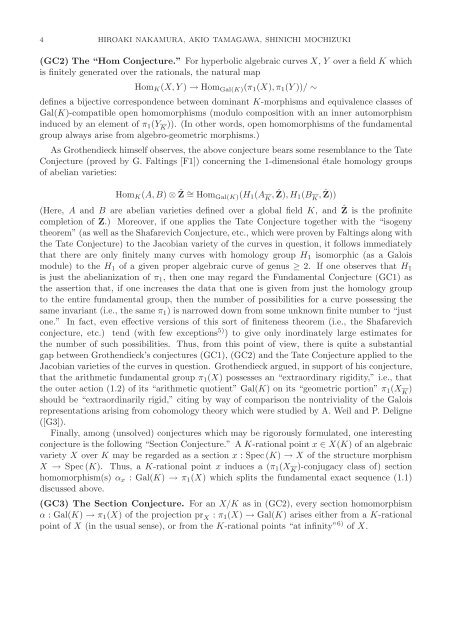The Grothendieck Conjecture on the Fundamental Groups of ...
The Grothendieck Conjecture on the Fundamental Groups of ...
The Grothendieck Conjecture on the Fundamental Groups of ...
Create successful ePaper yourself
Turn your PDF publications into a flip-book with our unique Google optimized e-Paper software.
4 HIROAKI NAKAMURA, AKIO TAMAGAWA, SHINICHI MOCHIZUKI<br />
(GC2) <str<strong>on</strong>g>The</str<strong>on</strong>g> “Hom <str<strong>on</strong>g>C<strong>on</strong>jecture</str<strong>on</strong>g>.” For hyperbolic algebraic curves X, Y over a field K which<br />
is finitely generated over <strong>the</strong> rati<strong>on</strong>als, <strong>the</strong> natural map<br />
Hom K (X, Y ) → Hom Gal(K) (π 1 (X),π 1 (Y ))/ ∼<br />
defines a bijective corresp<strong>on</strong>dence between dominant K-morphisms and equivalence classes <strong>of</strong><br />
Gal(K)-compatible open homomorphisms (modulo compositi<strong>on</strong> with an inner automorphism<br />
induced by an element <strong>of</strong> π 1 (Y K<br />
)). (In o<strong>the</strong>r words, open homomorphisms <strong>of</strong> <strong>the</strong> fundamental<br />
group always arise from algebro-geometric morphisms.)<br />
As <str<strong>on</strong>g>Gro<strong>the</strong>ndieck</str<strong>on</strong>g> himself observes, <strong>the</strong> above c<strong>on</strong>jecture bears some resemblance to <strong>the</strong> Tate<br />
<str<strong>on</strong>g>C<strong>on</strong>jecture</str<strong>on</strong>g> (proved by G. Faltings [F1]) c<strong>on</strong>cerning <strong>the</strong> 1-dimensi<strong>on</strong>al étale homology groups<br />
<strong>of</strong> abelian varieties:<br />
Hom K (A, B) ⊗ Ẑ ∼ = Hom Gal(K) (H 1 (A K<br />
, Ẑ),H 1(B K<br />
, Ẑ))<br />
(Here, A and B are abelian varieties defined over a global field K, and Ẑ is <strong>the</strong> pr<strong>of</strong>inite<br />
completi<strong>on</strong> <strong>of</strong> Z.) Moreover, if <strong>on</strong>e applies <strong>the</strong> Tate <str<strong>on</strong>g>C<strong>on</strong>jecture</str<strong>on</strong>g> toge<strong>the</strong>r with <strong>the</strong> “isogeny<br />
<strong>the</strong>orem” (as well as <strong>the</strong> Shafarevich <str<strong>on</strong>g>C<strong>on</strong>jecture</str<strong>on</strong>g>, etc., which were proven by Faltings al<strong>on</strong>g with<br />
<strong>the</strong> Tate <str<strong>on</strong>g>C<strong>on</strong>jecture</str<strong>on</strong>g>) to <strong>the</strong> Jacobian variety <strong>of</strong> <strong>the</strong> curves in questi<strong>on</strong>, it follows immediately<br />
that <strong>the</strong>re are <strong>on</strong>ly finitely many curves with homology group H 1 isomorphic (as a Galois<br />
module) to <strong>the</strong> H 1 <strong>of</strong> a given proper algebraic curve <strong>of</strong> genus ≥ 2. If <strong>on</strong>e observes that H 1<br />
is just <strong>the</strong> abelianizati<strong>on</strong> <strong>of</strong> π 1 , <strong>the</strong>n <strong>on</strong>e may regard <strong>the</strong> <strong>Fundamental</strong> <str<strong>on</strong>g>C<strong>on</strong>jecture</str<strong>on</strong>g> (GC1) as<br />
<strong>the</strong> asserti<strong>on</strong> that, if <strong>on</strong>e increases <strong>the</strong> data that <strong>on</strong>e is given from just <strong>the</strong> homology group<br />
to <strong>the</strong> entire fundamental group, <strong>the</strong>n <strong>the</strong> number <strong>of</strong> possibilities for a curve possessing <strong>the</strong><br />
same invariant (i.e., <strong>the</strong> same π 1 ) is narrowed down from some unknown finite number to “just<br />
<strong>on</strong>e.” In fact, even effective versi<strong>on</strong>s <strong>of</strong> this sort <strong>of</strong> finiteness <strong>the</strong>orem (i.e., <strong>the</strong> Shafarevich<br />
c<strong>on</strong>jecture, etc.) tend (with few excepti<strong>on</strong>s 5) ) to give <strong>on</strong>ly inordinately large estimates for<br />
<strong>the</strong> number <strong>of</strong> such possibilities. Thus, from this point <strong>of</strong> view, <strong>the</strong>re is quite a substantial<br />
gap between <str<strong>on</strong>g>Gro<strong>the</strong>ndieck</str<strong>on</strong>g>’s c<strong>on</strong>jectures (GC1), (GC2) and <strong>the</strong> Tate <str<strong>on</strong>g>C<strong>on</strong>jecture</str<strong>on</strong>g> applied to <strong>the</strong><br />
Jacobian varieties <strong>of</strong> <strong>the</strong> curves in questi<strong>on</strong>. <str<strong>on</strong>g>Gro<strong>the</strong>ndieck</str<strong>on</strong>g> argued, in support <strong>of</strong> his c<strong>on</strong>jecture,<br />
that <strong>the</strong> arithmetic fundamental group π 1 (X) possesses an “extraordinary rigidity,” i.e., that<br />
<strong>the</strong> outer acti<strong>on</strong> (1.2) <strong>of</strong> its “arithmetic quotient” Gal(K) <strong>on</strong> its “geometric porti<strong>on</strong>” π 1 (X K<br />
)<br />
should be “extraordinarily rigid,” citing by way <strong>of</strong> comparis<strong>on</strong> <strong>the</strong> n<strong>on</strong>triviality <strong>of</strong> <strong>the</strong> Galois<br />
representati<strong>on</strong>s arising from cohomology <strong>the</strong>ory which were studied by A. Weil and P. Deligne<br />
([G3]).<br />
Finally, am<strong>on</strong>g (unsolved) c<strong>on</strong>jectures which may be rigorously formulated, <strong>on</strong>e interesting<br />
c<strong>on</strong>jecture is <strong>the</strong> following “Secti<strong>on</strong> <str<strong>on</strong>g>C<strong>on</strong>jecture</str<strong>on</strong>g>.” A K-rati<strong>on</strong>al point x ∈ X(K) <strong>of</strong> an algebraic<br />
variety X over K may be regarded as a secti<strong>on</strong> x :Spec(K) → X <strong>of</strong> <strong>the</strong> structure morphism<br />
X → Spec (K). Thus, a K-rati<strong>on</strong>al point x induces a (π 1 (X K<br />
)-c<strong>on</strong>jugacy class <strong>of</strong>) secti<strong>on</strong><br />
homomorphism(s) α x : Gal(K) → π 1 (X) which splits <strong>the</strong> fundamental exact sequence (1.1)<br />
discussed above.<br />
(GC3) <str<strong>on</strong>g>The</str<strong>on</strong>g> Secti<strong>on</strong> <str<strong>on</strong>g>C<strong>on</strong>jecture</str<strong>on</strong>g>. For an X/K as in (GC2), every secti<strong>on</strong> homomorphism<br />
α :Gal(K) → π 1 (X) <strong>of</strong> <strong>the</strong> projecti<strong>on</strong> pr X : π 1 (X) → Gal(K) arises ei<strong>the</strong>r from a K-rati<strong>on</strong>al<br />
point <strong>of</strong> X (in <strong>the</strong> usual sense), or from <strong>the</strong> K-rati<strong>on</strong>al points “at infinity” 6) <strong>of</strong> X.

















